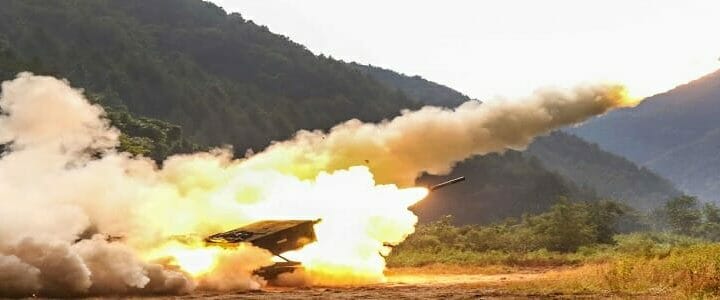No one said the road to a denuclearized Korean Peninsula would be a smooth one. North Korea’s long history of deceit, duplicity, and double-dealing is no secret, and for the moment, it is safe to assume they’re going to continue doing what they’ve always done. Three recent reports show how far the U.S. and the Democratic People’s Republic have to go to arrive at some kind of verifiable agreement.
Although I’ve allowed myself to hold out hope that Kim Jong-un is indeed different from his father and grandfather, I remain almost as skeptical as everyone else. The three reports — from the noted Korea-watchers Frank V. Pabian, Joseph S. Bermudez Jr. and Jack Liu at the Stimson Center’s 38North.com; NBC News reporters Courtney Kube, Ken Dilanian and Carol E. Lee; and Wall Street Journal reporter Jonathan Cheng — lay bare the cold reality that until the two countries sign a formal deal with hard, enforceable, and verifiable provisions, North Korea shows no signs of stopping its nuclear programs.
Yongbyon Reactor Activity
When Kim first expressed a willingness to talk, I pointed to a 38North report on how the 5MWe nuclear reactor at Yongbyon showed signs of restarting. Last Tuesday, 38North provided an update of activity at the Yongbyon site, which has produced the fuel used to make all of North Korea’s nuclear weapons to date. No surprise, the site reported that “improvements to the infrastructure… are continuing at a rapid pace.”
Satellite imagery appears to show that the modifications to the reactor’s cooling system begun in March are nearing completion. Analysts could not tell if the reactor is running now, although it seemed unlikely to be running at a high level if at all based on the water discharging from the cooling system.
Nevertheless, the new system appears to be complete. Whatever the reason for the modifications, the reactor is likely ready to resume producing the plutonium needed to produce additional nuclear weapons to add to the dozen-or-so believed already to be in the DPRK’s arsenal.
NBC’s intel bombshell
Mere days after meeting with Kim, President Donald Trump famously claimed there was no longer a nuclear threat from North Korea. Absolutely no one believes him, and NBC News spoke to “more than a dozen American officials” about how North Korea’s programs continue apace. The most damning but least surprising information in NBC’s Friday report was that the DPRK has been increasing its nuclear fuel production “at multiple secret sites in recent months.” We know about Yongbyon, and observers have been fairly certain there’s another production facility somewhere else.
NBC reports that intelligence officials believe there is a third site, although they didn’t provide any additional information.
While some expressed shock that so many U.S. officials spoke openly, if anonymously, I’m not one of them. Having known Courtney Kube for more than a decade, I can state she is well-respected by the national security establishment and can be trusted to get the story right. And I think there’s an ulterior motive.
Through NBC, intel officials are letting Kim’s generals know that we know about the other sites, and probably know where they are. I’ve written before about leaking strategically to observe your adversary’s reaction to the revelation that you know their secrets. This is almost certainly one of those times. I suspect the intelligence community is learning a lot from North Korea’s reaction to the story.
More work on solid-fuel missiles
Kim also promised to begin to dismantle a rocket engine test site, suspected to be the on at Sohae. But as of last week, there was no evidence of any work to dismantle that facility. Not only that, but the Wall Street Journal reported Sunday that construction at a site for building solid-fuel medium-range ballistic missiles capable of carrying a nuclear weapon a distance of 800 miles was continuing rapidly.
Kim visited the site outside the DPRK’s second-largest city, Hamhung, last year. He promised to expand the missile manufacturing plant there. By comparing satellite photos taken on April 1 and June 12, experts believe he has done just that. At the very least, the Koreans have succeeded in putting shiny, painted roofs on what was completed in April, and in paving the roads throughout the compound. The state of construction beneath those roofs — to me anyway — remains to be determined. Since most satellites take photos only while looking straight down, it’s hard to tell what’s going on behind the shiny new facades.
But if nothing else, the rapid construction of those roofs shows both North Korea’s intent to continue these types of projects, and to do so in a way that makes it as difficult as possible to determine exactly what they’re up to.
The U.S.-DPRK diplomatic wrangling will continue despite Korea’s actions. 38North was quick to point out that “Continued work at the Yongbyon facility should not be seen as having any relationship to North Korea’s pledge to denuclearize.” Just as I’ve said that no one in the U.S. government takes actions based solely on a Trump Tweet, so too do the North Koreans need to receive formal, detailed orders. “The North’s nuclear cadre,” 38North said, “can be expected to proceed with business as usual until specific orders are issued from Pyongyang.”




